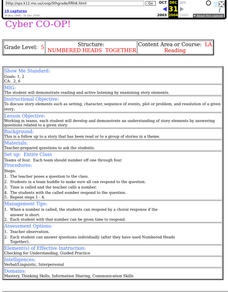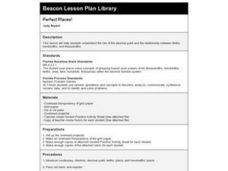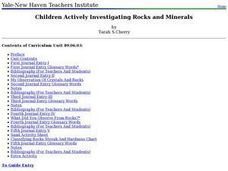Curated OER
Poetry in Music
Sixth graders look at poetry in music. In this language arts lesson, 6th graders listen to and read the lyrics of songs to find the poetic aspects of them. They focus on similes and metaphors and write their own songs lyrics.
Curated OER
Making Cookies- How many per hour?
Fifth graders measure how long it takes to make cookies. In this measuring time activity, 5th graders explore how to manage time. Students decide when to start making breakfast on time, how to calculate playing time into their lunch...
Curated OER
Fan(tom) of the Opera
Students explore the ways in which the worlds of popular music and opera can work together to complement the other. They work in small groups to analyze plot, characters, setting and themes of a popular opera using a summary of that...
Curated OER
Daily Weather Calendar
Third graders use the internet to record the daily weather conditions. Using symbols, they take the information they gathered and create an easy to read chart. They share their charts with the class to end the activity.
Curated OER
Numbered Heads Together
Fifth graders demonstrate reading and active listening by examining story elements. Working in teams, each student will develop and demonstrate an understanding of story elements by answering questions related to a given story.
Curated OER
Ancient Roman Monuments and Timeline
While a terrific idea, this lesson in which learners create a timeline showing the date that a variety of buildings and monuments were built in Ancient Rome, requires resources teachers may not have. It requires the use of a Smartboard,...
Curated OER
Touch Math
Using the touch math system, learners engage in activities to practice adding numbers. While the lesson is laid out in an explicit manner, there isn't a guide explaining the touch math system.
Curated OER
Holes, by Louis Sachar
Students use reading fluency, comprehension, vocabulary, written expression to write in journals as reading "Holes" by Louis Sachar. Some days are set aside for tests and/or food tasting.
Curated OER
The Great Depression Changes Ameirican Life
Students examine the impact of the Great Depression. In this Great Depression lesson, students research employment opportunities during the era. Students determine how they may have been able to survive the economic depression if they...
Curated OER
Perfect Places!
Second graders study the decimal point and study tenths, hundredths, and thousandths. They explain ways to read and write decimals.
Curated OER
Summarizing is Fun with Flat Stanley!
Students read the book "Flat Stanley" by Jeff Brown. Through modeling and guided practice, as a class, they complete a story map and 1-paragraph summary of the first chapter in the book. Then, in groups, they follow the same procedure...
Curated OER
Hindsight is 20-20Presidential First 100 DaysPresentation
Students interpret historical evidence presented in primary and secondary resources. For this American history lesson, students research the first 100 days of several American Presidents. Students use their research findings...
Curated OER
Maintaining Plant Genebanks
Students examine the use, costs, and the need for plant gene banks. The rationale for gaining ownership over scientific information and the implications of the developing nations' reliance on biotechnology is explored in this...
Curated OER
New England Colonies
Students study the New England colonies. For this colonies lesson, students use a directed reading-thinking method to learn about the New England colonies. Students follow the method to make predictions, read the text, and analyze the...
Curated OER
Were Lewis and Clark respectful to the Native Americans they encountered on their journey?
Sixth graders debate whether or not Lewis and Clark were respectful of Native Americans they encountered on their journey. In this American History lesson, 6th graders review primary documents and diary entries from the Lewis and Clark...
Curated OER
Harry Potter Alive and Well In the Sorcerer's Stone
Students brainstorm author's purpose, and use their imagination to draw pictures that illustrate what the purpose is. In this literature and writing lesson, student's use Harry Potter and the Sorcerer's Stone as a guide from which to work.
Curated OER
Children Actively Investigating Rocks and Minerals
Students follow directions to set up their own record keeping journal. As a class, they are introduced to the characteristics of crystals and identify three types of crystals they see in their everyday lives. They examine materials they...
Curated OER
International Curiosity and National Pride
Students look at their own culture and at Bulgarian culture to identify national, local, or ethnic traits. They identify at least three important characteristics of their culture that help make it unique and compose a list of questions...
Curated OER
Make a Snowflake
Students study the design of snowflakes. In this snow lesson, students discover the different shapes of a snowflake, and their similarities. Students study snowflakes outside, then create their own with popsicle sticks and glue.
Curated OER
Emotions with Corduroy
First graders, after reading Corduroy, relate Corduroy's emotions to their own emotions in a 'feelings chart'. They relate feelings of friendship, acceptance and belonging.
Curated OER
Draw It!
Students follow directions to make two- and three-dimensional shapes. Focusing on polygons, they use the shapes to solve real-world problems and review with the class. They read two of Shel Silverstein's poems and discuss the...
Curated OER
Ugly? Says Who?
Students explore biology by writing animal poetry in class. In this animal characteristics lesson, students research the Internet for facts about an "ugly" animal such as a bug or small critter. Students complete worksheets about animal...
Curated OER
Give Me Five at Christmas Time
Students study about senses by taking a walking field trip, creating a word bank, reading a story and singing a song.
Curated OER
Slope Right Up
Learners use triangles to find the length and slope of each side. After connecting the vertices, they add points based on their specific instructions. They use the Pythagorean Theorem to complete a worksheet to end the lesson.

























